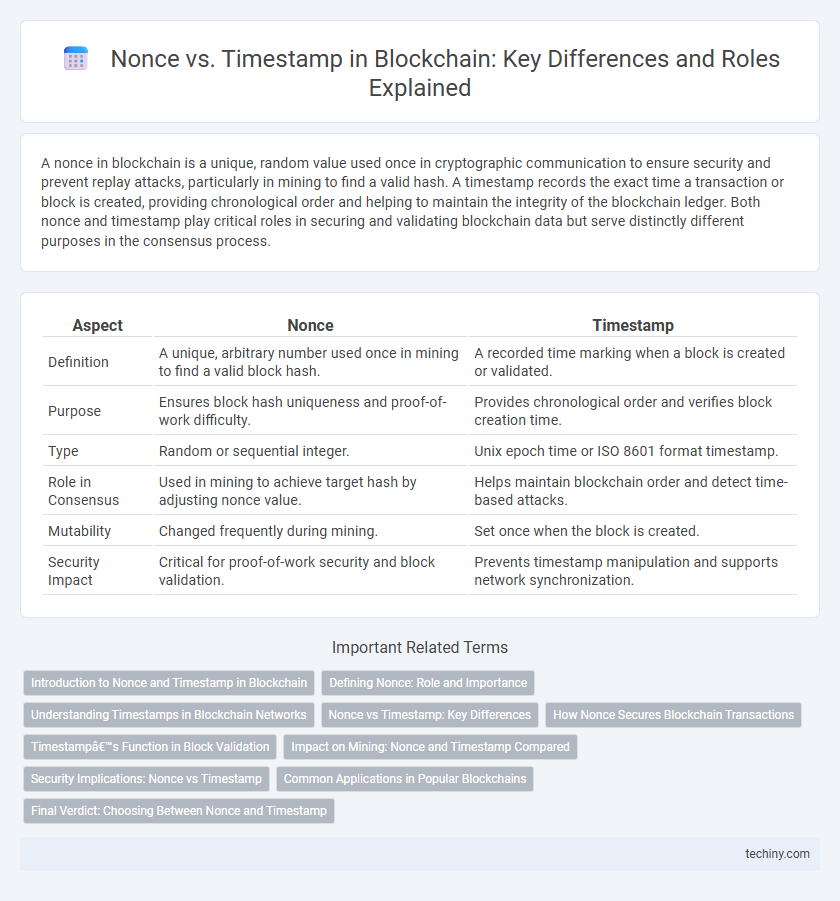A nonce in blockchain is a unique, random value used once in cryptographic communication to ensure security and prevent replay attacks, particularly in mining to find a valid hash. A timestamp records the exact time a transaction or block is created, providing chronological order and helping to maintain the integrity of the blockchain ledger. Both nonce and timestamp play critical roles in securing and validating blockchain data but serve distinctly different purposes in the consensus process.
Table of Comparison
| Aspect | Nonce | Timestamp |
|---|---|---|
| Definition | A unique, arbitrary number used once in mining to find a valid block hash. | A recorded time marking when a block is created or validated. |
| Purpose | Ensures block hash uniqueness and proof-of-work difficulty. | Provides chronological order and verifies block creation time. |
| Type | Random or sequential integer. | Unix epoch time or ISO 8601 format timestamp. |
| Role in Consensus | Used in mining to achieve target hash by adjusting nonce value. | Helps maintain blockchain order and detect time-based attacks. |
| Mutability | Changed frequently during mining. | Set once when the block is created. |
| Security Impact | Critical for proof-of-work security and block validation. | Prevents timestamp manipulation and supports network synchronization. |
Introduction to Nonce and Timestamp in Blockchain
Nonce and timestamp serve distinct but complementary roles in blockchain technology, with the nonce acting as a variable number used in mining to find a hash that meets the network's difficulty target. The timestamp records the exact time a block is created, ensuring chronological order and validating transaction sequences within the blockchain. These elements collectively enhance security, prevent double-spending, and maintain the integrity of the distributed ledger.
Defining Nonce: Role and Importance
Nonce in blockchain is a unique, arbitrary number used once to vary the input of hash functions, ensuring the security and integrity of mining processes. It plays a crucial role in proof-of-work consensus by enabling miners to find a hash value below a target threshold, validating new blocks. Unlike timestamps, which record the exact creation time, the nonce drives computational effort to prevent double-spending and maintain network trust.
Understanding Timestamps in Blockchain Networks
Timestamps in blockchain networks record the exact time a block is added to the chain, ensuring chronological order and data integrity across distributed nodes. Unlike the nonce, which is a variable used in mining to solve cryptographic puzzles, timestamps provide a verifiable time reference that helps prevent double-spending and reorganizations. Accurate timestamping supports consensus protocols by enabling synchronization and auditability within decentralized ledgers.
Nonce vs Timestamp: Key Differences
Nonce and timestamp are critical elements in blockchain, serving distinct functions where nonce is a random or pseudo-random number used once to guarantee unique cryptographic hash outputs, essential for mining and consensus protocols. Timestamp records the exact time a block is created, ensuring chronological order and preventing double-spending by marking transaction sequences. Together, nonce secures proof-of-work integrity while timestamp maintains blockchain's temporal structure, highlighting their complementary yet fundamentally different roles.
How Nonce Secures Blockchain Transactions
Nonce plays a critical role in securing blockchain transactions by ensuring the uniqueness of each cryptographic hash, preventing replay attacks and double-spending. Unlike timestamps, which record when a transaction occurs but can be manipulated, nonces are random or sequential values used in mining to find a valid hash under the network's difficulty target. This proof-of-work mechanism verifies transaction authenticity and integrity, maintaining the blockchain's decentralized security and trust.
Timestamp’s Function in Block Validation
Timestamp serves as a crucial component in block validation by recording the precise time a block is created, ensuring chronological order within the blockchain. It helps prevent double-spending attacks and maintains network consensus by verifying that blocks are added at valid intervals. Accurate timestamps enable smart contracts and decentralized applications to operate reliably by triggering events based on real-world time constraints.
Impact on Mining: Nonce and Timestamp Compared
Nonce directly influences mining by enabling miners to repeatedly alter the block header hash to meet the network's difficulty target, driving the Proof of Work consensus. Timestamp impacts mining by providing a chronological order for blocks and preventing potential replay attacks, yet it offers limited control over the mining process itself compared to the nonce. Efficient mining relies primarily on nonce variation to discover valid hashes, while timestamp adjustments ensure network stability and integrity.
Security Implications: Nonce vs Timestamp
Nonce and timestamp serve distinct security roles in blockchain technology; nonces prevent replay attacks by ensuring each transaction is unique, while timestamps provide chronological ordering and help detect delayed or out-of-sequence transactions. Nonces enhance resistance to double-spending by requiring miners to solve unique proof-of-work puzzles, whereas timestamps contribute to network consensus by verifying the validity of block intervals and are crucial for time-sensitive smart contracts. Mismanagement of nonces can lead to transaction malleability, whereas inaccurate timestamps may enable time-warp attacks, compromising blockchain integrity.
Common Applications in Popular Blockchains
Nonces serve as crucial cryptographic elements in blockchain mining processes, primarily used in Proof of Work (PoW) consensus algorithms like Bitcoin and Ethereum to adjust the hash output and meet difficulty targets. Timestamps provide chronological ordering of blocks, ensuring transaction sequencing and network synchronization in blockchains such as Bitcoin and Hyperledger Fabric. Both nonces and timestamps play essential roles in maintaining security, consensus integrity, and transaction verification within popular blockchain ecosystems.
Final Verdict: Choosing Between Nonce and Timestamp
Nonce provides enhanced security for blockchain transactions by ensuring uniqueness and preventing replay attacks, making it essential for proof-of-work consensus mechanisms. Timestamp offers chronological ordering and auditability, which is critical for maintaining transaction history and synchronization across distributed ledgers. Choosing between nonce and timestamp depends on the specific blockchain use case, prioritizing security and uniqueness through nonce or transaction sequencing and verification through timestamps.
Nonce vs Timestamp Infographic

 techiny.com
techiny.com